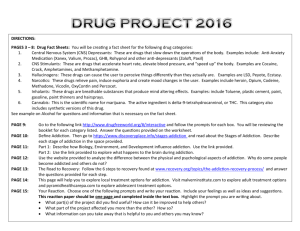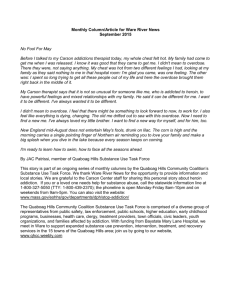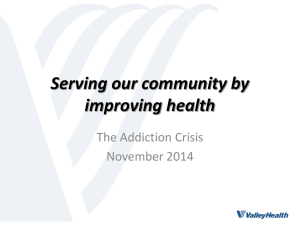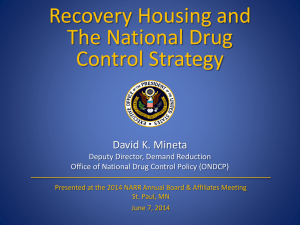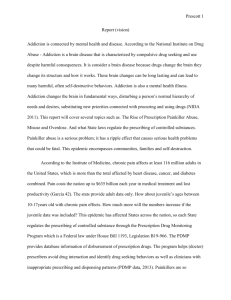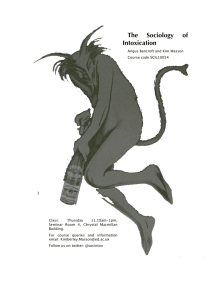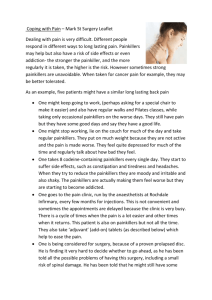Drug Project Template
advertisement
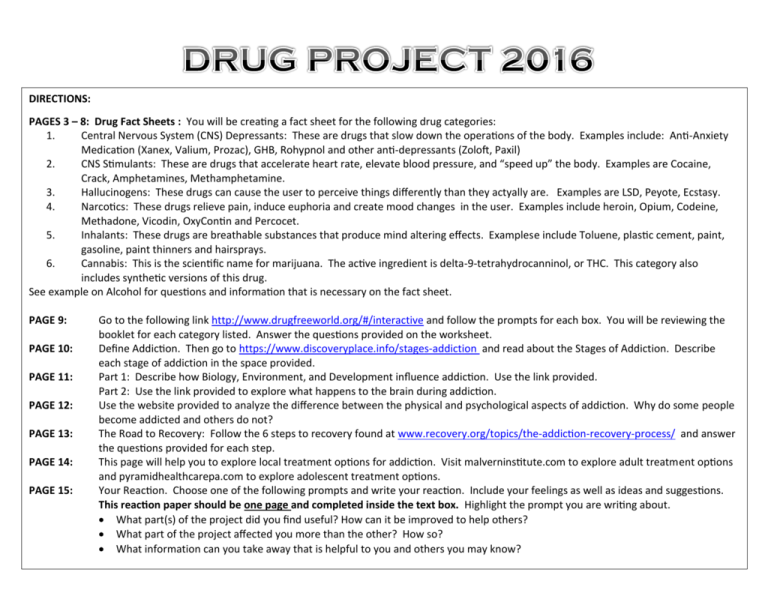
DIRECTIONS: PAGES 3 – 8: Drug Fact Sheets : You will be creating a fact sheet for the following drug categories: 1. Central Nervous System (CNS) Depressants: These are drugs that slow down the operations of the body. Examples include: Anti-Anxiety Medication (Xanex, Valium, Prozac), GHB, Rohypnol and other anti-depressants (Zoloft, Paxil) 2. CNS Stimulants: These are drugs that accelerate heart rate, elevate blood pressure, and “speed up” the body. Examples are Cocaine, Crack, Amphetamines, Methamphetamine. 3. Hallucinogens: These drugs can cause the user to perceive things differently than they actyally are. Examples are LSD, Peyote, Ecstasy. 4. Narcotics: These drugs relieve pain, induce euphoria and create mood changes in the user. Examples include heroin, Opium, Codeine, Methadone, Vicodin, OxyContin and Percocet. 5. Inhalants: These drugs are breathable substances that produce mind altering effects. Examplese include Toluene, plastic cement, paint, gasoline, paint thinners and hairsprays. 6. Cannabis: This is the scientific name for marijuana. The active ingredient is delta-9-tetrahydrocanninol, or THC. This category also includes synthetic versions of this drug. See example on Alcohol for questions and information that is necessary on the fact sheet. PAGE 9: PAGE 10: PAGE 11: PAGE 12: PAGE 13: PAGE 14: PAGE 15: Go to the following link http://www.drugfreeworld.org/#/interactive and follow the prompts for each box. You will be reviewing the booklet for each category listed. Answer the questions provided on the worksheet. Define Addiction. Then go to https://www.discoveryplace.info/stages-addiction and read about the Stages of Addiction. Describe each stage of addiction in the space provided. Part 1: Describe how Biology, Environment, and Development influence addiction. Use the link provided. Part 2: Use the link provided to explore what happens to the brain during addiction. Use the website provided to analyze the difference between the physical and psychological aspects of addiction. Why do some people become addicted and others do not? The Road to Recovery: Follow the 6 steps to recovery found at www.recovery.org/topics/the-addiction-recovery-process/ and answer the questions provided for each step. This page will help you to explore local treatment options for addiction. Visit malverninstitute.com to explore adult treatment options and pyramidhealthcarepa.com to explore adolescent treatment options. Your Reaction. Choose one of the following prompts and write your reaction. Include your feelings as well as ideas and suggestions. This reaction paper should be one page and completed inside the text box. Highlight the prompt you are writing about. What part(s) of the project did you find useful? How can it be improved to help others? What part of the project affected you more than the other? How so? What information can you take away that is helpful to you and others you may know? AKA: BOOZE, BREW, handle, Long Term Effects on the Body: Unintentional Injuries 40, Cold-one, JUICE Heart Disease Liver Disease / Ulcers How is it made? How is the drug brought into the body? Where does it come from? Drink Alcohol is made from the fermentation of fruit or grain mixtures (beer), and can then be followed up with distillation of the fermented fruit or grain (hard liquor, wine) Tampons Beer Bongs Squeeze applesauce Indicators of Intoxication: Signs of Overdose: Impaired judgement Critical Signs and Symptoms of Alcohol Poisoning Slurred Speech Blurry Vision Upset Stomach / Diarrhea Vomiting Breathing Difficulties Drowsiness Smell of Alcohol on Breath Blackouts Effects last up to 2 hours after consumption and in urine for 1224 hours later. High Blood Pressure / Stroke What is the drug? Ethanol is the key ingredient in drinking alcohol. Alcohol is mixed with other fluids to create drinks. These range in alcohol content from 2% - 60%. Beer typically contains 2% - 20% and hard liquor from 40% - 60%. How long do the effects last? Risks of Use: Unintentional Injuries DUI / Car Accidents Alcohol Poisoning Unintentional Pregnancy Sexually Transmitted Disease /AIDS / Rape Relationship Risks Mental Confusion /Stupor /Inability to wake up Seizures Slow Breathing Irregular Breathing Hypothermia Intensive Vomiting AKA: Long Term Effects on the Body: How long do the effects last? What is the drug? How is the drug brought into the body? How is it made? ONE PICTURE of the drug Where does it come from? Indicators of Intoxication: Signs of Overdose: Risks of Use: AKA: Long Term Effects on the Body: How long do the effects last? What is the drug? How is the drug brought into the body? How is it made? ONE PICTURE of the drug Where does it come from? Indicators of Intoxication: Signs of Overdose: Risks of Use: AKA: Long Term Effects on the Body: How long do the effects last? What is the drug? How is the drug brought into the body? How is it made? ONE PICTURE of the drug Where does it come from? Indicators of Intoxication: Signs of Overdose: Risks of Use: AKA: Long Term Effects on the Body: How long do the effects last? What is the drug? How is the drug brought into the body? How is it made? ONE PICTURE of the drug Where does it come from? Indicators of Intoxication: Signs of Overdose: Risks of Use: AKA: Long Term Effects on the Body: How long do the effects last? What is the drug? How is the drug brought into the body? How is it made? ONE PICTURE of the drug Where does it come from? Indicators of Intoxication: Signs of Overdose: Risks of Use: AKA: Long Term Effects on the Body: How long do the effects last? What is the drug? How is the drug brought into the body? How is it made? ONE PICTURE of the drug Where does it come from? Indicators of Intoxication: Signs of Overdose: Risks of Use: Go to the following link http://www.drugfreeworld.org/#/interactive and follow the prompts for each box. You will be reviewing the booklet for each category listed. PRESCRIPTION DRUGS/PAINKILLERS PRESCRIPTION DRUGS/PAINKILLERS Why are so many young people turning to prescription painkiller drugs to get “high”? What represents ¾ of the overall problem of prescription drug abuse? What substance is 30-50 times more powerful than heroin? How many people have been attributed to deaths due to this substance in 2007? What can long term use of painkillers lead to? Briefly describe what that is. What are the most powerful painkillers called? They were manufactured to have what purpose? What are the names of the most powerful painkillers? HEROIN What happened between 1995 and 2002? How does Sabrina describe a day in the life of an addict? Using the chart below describe the connection between the below listed drugs: Codeine, Oxycontin, Heroin and Fetanyl https://www.discoveryplace.info/stages-addiction Stage 1 Stage 2 Stage 3 Stage 4 http://www.drugabuse.gov/publications/drugfacts/understanding-drug-abuse-addiction Biology Environment Development http://www.neshaminy.k12.pa.us/cms/lib6/PA01000466/Centricity/Domain/330/Drug%20Info%20on%20Brain.pdf Frontal Lobe Limbic System Lower Brain Stem http://www.rehabs.com/just-the-facts-psychological-vs-physical-addiction/ Physical Addiction Psychological Addiction Click on the link to research to following information: http://www.recovery.org/topics/the-addiction-recovery-process/ Step 1: Decide to Make a Change List 4 lifestyle changes you can make Step 2: Step 3: Explore Treatment Options Find Support 1. Where can you find support? 2. 3. Step 4: Make Sobriety Last How do you maintain sobriety and avoid relapse? 12 Step Programs: Step 5:What do they do? Name the 3 examples Build a Meaningful Life Without Drugs How do you rebuild a new life? Step 6: Never Lose Hope What do you have to do? Adult Treatment Malvern Institute http://www.malverninstitute.com/ 1. Click on the link for Admissions and Intervention and answer the following: What is admissions based on: 2. Click on the link for Inpatient Services, in the box describe the 2 types of inpatient services 1. Adolescent Treatment Pyramid Health in Quakertown https://www.pyramidhealthcarepa.com/ 1. Click on the link detox and answer the following: What does detoxification do? 2. Click on the link for Inpatient Residential Services and describe what the inpatient program is designed to do Program is designed to: 2. 3. Click on the link for Family Programs and ROC, what is the goal for the family program and what topics are covered What is admissions based on: Goal: Topics: 3. Click on the link for Outpatient Treatment, what does the outpatient program provide? Outpatient programs provide: Choose one of the following prompts and write your reaction. Include your feelings as well as ideas and suggestions. This reaction paper should be one page and completed inside the text box. Highlight the prompt you are writing about. What part(s) of the project did you find useful? How can it be improved to What part of the project affected you more than the other? help others? How so? What information can you take away that is helpful to you and others you may know?
